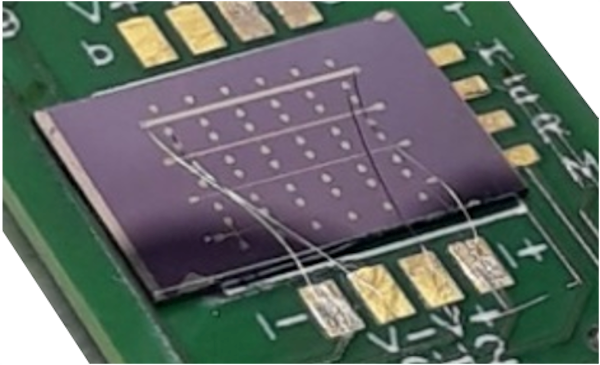Researchers at SPINTEC Grenoble, in collaboration with PHELIQS & CIME Grenoble and LOMA Bordeaux, demonstrated how the superconducting proximity effect can be used to evaluate the penetration of Cooper pairs in metallic antiferromagnets. These findings represent a stimulating example of how antiferromagnets and superconductors may envision a common future by showing how to infer essential information using Cooper pair transport through antiferromagnets.

Picture of a typical device used to perform transport measurements.
The interplay between superconductivity and magnetism has attracted considerable attention in recent decades due to its importance for studies in basic physics and related applications. As a consequence, a variety of phenomena have been described in ferromagnet/superconductor hybrids, such as the spin switch effect, the superconducting magnetoresistance effect, and domain wall superconductivity. At the heart of domain wall superconductivity, Cooper pairs consisting of electrons of opposing spins experience the short-range exchange field averaged over the superconducting coherence length. This phenomenon reduces the critical temperature (TC) of the superconducting layer. A magnetic domain wall flanked by opposite spins reduces the averaged exchange field and thus allows partial recovery of the superconducting temperature, ΔTC. Recovery can be achieved through the creation of an additional – and more efficient – superconducting pathway in the magnetic layer.
The main contribution of this paper is that it presents a systematic investigation of the superconducting proximity effect in ferromagnet(Pt/Co)/spacer(IrMn and Pt)/superconductor(NbN) heterostructures. The findings presented indicate that by tuning the various parameters in play, the recovery of the superconducting critical temperature in the presence of ferromagnetic domains and domain walls can be maximized to a degree that makes it possible to carry out two types of studies that were previously impossible. We were therefore able to: i) probe how the recovery of the superconducting critical temperature gradually evolves with all the intermediate magnetic configurations of the ferromagnet; and, ii) determine that the recovery of the superconducting critical temperature gradually reduces with the thickness of the metallic spacer layer. Most importantly, these experiments allowed us to evaluate the penetration of Cooper pairs in the IrMn metallic antiferromagnet, information which is crucial for electronic transport, and up to now has been difficult to access experimentally for antiferromagnets.
The results presented open a new pathway for the investigation of electronic transport in antiferromagnetic materials for spintronics.
Teams: Antiferromagnetic Spintronics
Collaboration: PHELIQS Grenoble, CIME Grenoble, LOMA Bordeaux
Funding: ANR-15-CE24-0015-01, PE-18P31-ELSA, OSR-2015-CRG4-2626
Further reading: Penetration depth of Cooper pairs in the IrMn antiferromagnet, R. L. Seeger, G. Forestier, O. Gladii, M. Leiviskä, S. Auffret, I. Joumard, C. Gomez, M. Rubio-Roy, A. I. Buzdin, M. Houzet, and V. Baltz, Phys. Rev. B 104, 054413 (2021).
Contact: Vincent BALTZ




